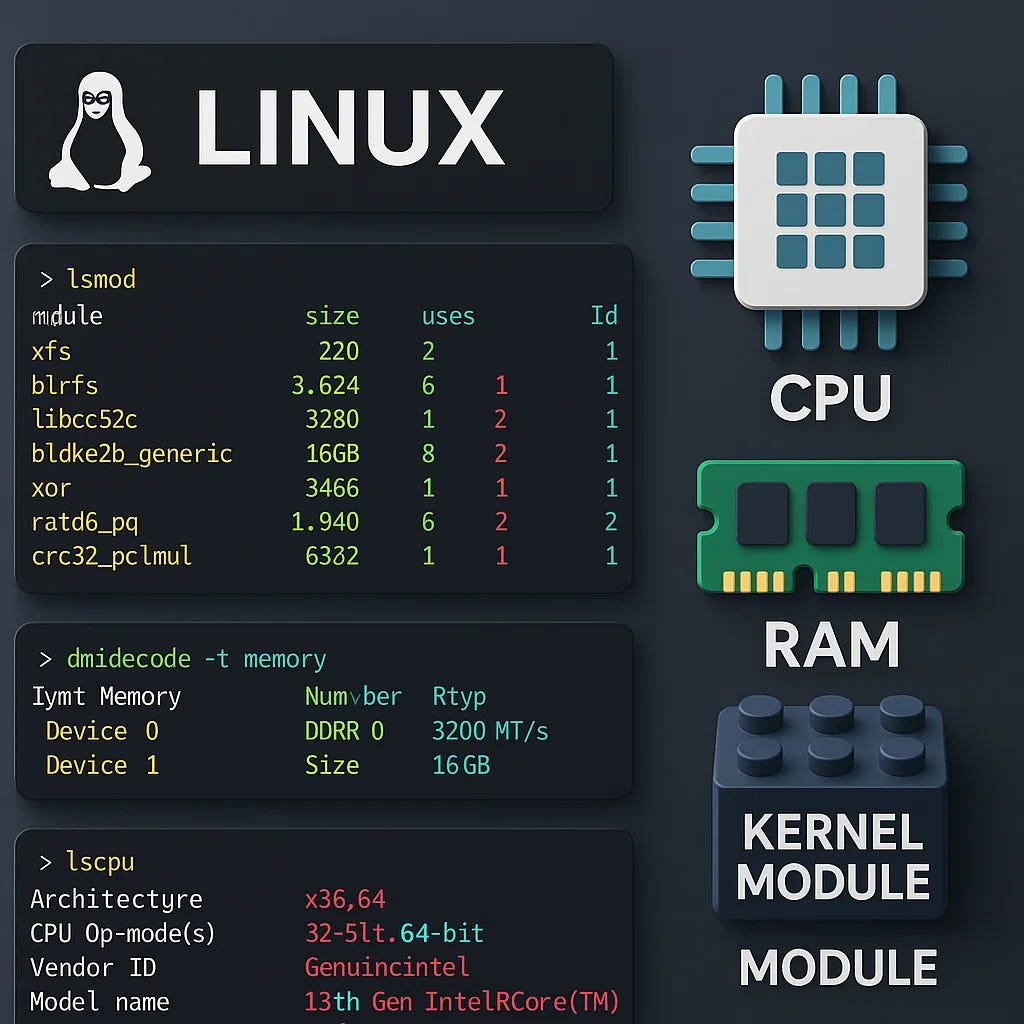How Linux Talks to Hardware and Why You Should Care
Subtitle: From IoT to performance tuning, here’s how kernel modules and hardware info tools help Linux stay sharp and smart.
Imagine Linux as the brain of your computer — and every device it connects to (from your mouse to a smart toaster) is a limb it controls. But how does the brain understand what the limbs are, and how they work?
Welcome to the world of Device Management.
This article breaks down the essentials of how Linux handles hardware, kernel modules, and deeper diagnostics, in a no-jargon, friendly tone. Think of it as giving your Linux system X-ray vision.
🧠 Why Should You Care?
- You’re working with specialized hardware (IoT, edge devices, sensors).
- You want to optimize or troubleshoot performance in real-time.
- You’re exploring Linux internals or building custom scripts.
- Or maybe you’re just curious how your OS magically knows your RAM size.
Even if you’re not a kernel hacker, understanding these tools gives you more confidence and control — plus, they make you look like a pro.
🧩 Kernel Modules: Plug-and-Play Superpowers
Kernel modules are like Lego blocks — extra pieces that add new powers to your Linux system without rebooting.
🚀 Loading Modules
insmod: Loads a module manually (no dependency checks, full path required). So it lacks error-handling when there is a missing dependency, need to be used with caremodprobe: The smarter way — loads module + dependencies by just the name. So there will be be no dependency failures as in the case of inside- Use
-ato load multiple,-nfor dry run,-vfor verbose,-fto force it. rmmod: Removes a module — careful though! It doesn’t check if other modules need it. So if some module is dependent on this one, then it doesn’t check this and removes it. So always cautious while using this.
Example:
sudo modprobe my_module
sudo rmmod my_module🔍 Module Info & Dependencies
Before you install or remove a module, it’s wise to understand what it relies on.
📂 depmod
Scans available modules, maps out dependencies, and builds a helper file for modprobe.
sudo depmod
cat /lib/modules/$(uname -r)/modules.dep | grep test📊 lsmod
See what’s currently loaded:
- Name, size, and what depends on it.
- Great for debugging, freeing up memory, or spotting suspicious modules.
- For example, from a security aspect you can find any malicious modules which are consuming the memory and should be stoped. Also for troubleshooting dependency issues
ℹ️ modinfo
Gives detailed info about a module:
- Description, author, license, parameters, dependencies.
- Useful for finding specs and requirements of a module
modinfo bluetooth🖥️ Hardware Info Commands
Want to know what your system is really made of? These commands spill the beans.
🧬 dmidecode
Pulls data from the DMI table (BIOS, motherboard, CPU, RAM info).
sudo dmidecode -t cpuUse this to verify hardware, plan upgrades, or just flex your geek muscles.
Can it run Crysis? And if you want to check the spec of your system before running crysis you can do it with this
🧠 lscpu
Gives a structured CPU summary (cores, threads, cache, virtualization).
lscpu -eGreat for fine-tuning workloads or checking offline CPUs. Checking if all the cores are loaded and working properly, and distributing among the system.
Very useful for making high computing systems, optimising database queries, seeing cache details etc.
💾 lsmem
Shows how your memory is structured and allocated.
- Useful to check for removable memory, RAM blocks, or memory limits before deploying something resource-heavy.
🧵 TL;DR
- Use
modprobe, notinsmod, unless you know what you’re doing. - Before removing a module, check with
lsmodandmodinfo. - Dive into your hardware with
dmidecode,lscpu, andlsmem. - Device management is not just for sysadmins — it’s for anyone who wants more insight and control.
So next time someone asks what your Linux system is made of, don’t just say “magic” — open the terminal and prove it like a nerdy wizard in control. 🧙♂️💻
